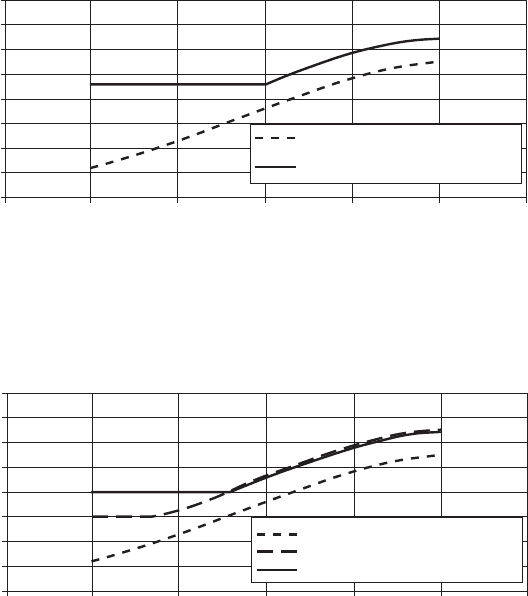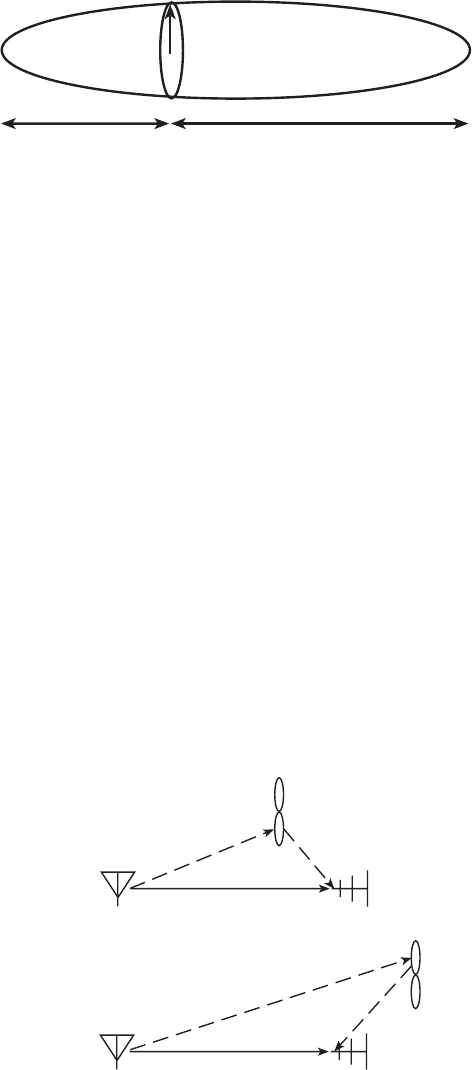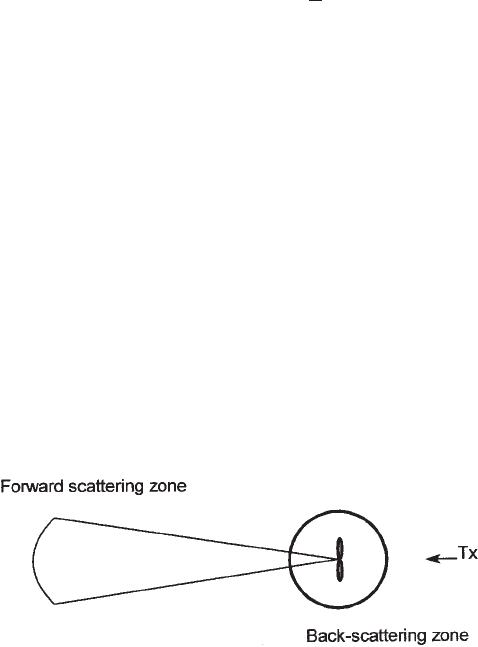Burton T. (et. al.) Wind energy Handbook
Подождите немного. Документ загружается.


The apparent A-weighted sound pow er level of the turbine is then calculated
from
L
WA,ref
¼ L
Aeq,ref
þ 10 log
10
(4R
2
i
) 6(9: 18)
where R
i
is the slant distance from the microphone to the wind turbine hub.
It may be seen that the calculation of sound power level assumes spherical
radiation of the noise from the hub of the turbine. The subtraction of 6 dB is to
determine the free field sound pre ssure level from the measurements and to correct
for the approximate pressure doubling that occurs with the microphone located on
a reflecting board at ground level.
The directivity, DI, is the difference between the A-weighted sound pressure
level at measurement points i ¼ 2–4 and the reference point 1, downstream of the
turbine. It is calculated from
DI
i
¼ L
Aeq,i
L
Aeq,1
þ 20 log
10
R
i
R
1
(9:19)
One of the Appendices of the IEA document (International Energy Agency, 1994)
provides a method to estimate the sound pressure level of a single turbine or gro up
of turbines at a distance R provided that they are located in flat and open terrain.
The calculation is based on hemispherical spreading (Equation 9.20)):
3
RO
600
4
2
1 (reference measuring point)
Wind direction ⫹/⫺ 150
Figure 9.10 Recommended Pattern for Measuring Points from IEA Recommended Practices
for Wind Turbine Testing (after IEA, 1994, and BS EN 61400–11)
NOISE 535
L
P
(R) ¼ L
W
10 log
10
(2R
2
) ˜L
a
(9:20)
The correction ˜L
a
is for atmospheric absorption and can be calculated from
˜L
a
¼ RÆ where Æ is a coefficient for sound absorption in each octave band and R
is the distance to the turbi ne hub. An alternative approach is to use a similar
equation to (9.20) but with Æ as 0:005 dB=m (as suggested in the Danish Statutory
Order on Noise from Wi ndmills, 1991) and L
W
specified as a single, broadband
sound power level.
If there are several wind turbines which influence the sound pressure level the
individual contributions are calculated separately and summed using
L
1þ2þ::
¼ 10 log
10
(10
L
1
=10
þ 10
L
2
=10
þ ...)(9:21)
Interestingly, the IEA Appendix concludes with the remark that in tests on small
and medium sized wind turbines (55–300 kW), the noise levels predicted in this
way were in reasonable agreement with measured noise levels (deviations of A-
weighted sound pres sure levels generally within þ=2 dB) but that serious differ-
ences were found when the prediction was based on more detailed prediction
methods.
The IEA Method (1994) for determinin g sound pressure levels at a point is based
on hemispherical spreading with a correction for atmospheric absorption. The
assumption of hemispherical spreading gives a reduction of 6 dB per doub ling of
distance. Under some conditions, particularly downwind, this may be an optimistic
assumption and a reduction of 3 dB per doubling of distance is more realistic. The
IEA Method also ignores any effects of meteorological gradients (Wagner, Bareis
and Guidati, 1996). Under normal conditions, air temperature decreases with height
and so the sound speed will decrease with increasing height and cause the path of
the sound to curve upwards. However, under conditions of temperature inversion,
e.g., as might prevail on cold winter nights, the temperature increases with height
causing the sound to curve downwards. Wind speed will have a similar effect. In
the downwind direction the sound will be bent downwards while a shadow zone is
formed upwind. The effect of the upwind shadow zone is more pronounced at
higher frequencies.
A comprehensive study of noise propagation is reported in ETSU/W/13/00385/
REP (ETSU, 2000). The results of this study, which included field experiments,
support the concerns over the use of very complex models voiced by the IEA and
the study concluded that ‘... significant and consistent correlation only exists
between the sound pressure level and vector wind speed’. Hence the study
proposes that a rather straightforward spherical propagation model should be
assumed with additional terms included to account for directivi ty, air absorption,
and in some cases special topographical features between the source and the
converter.
A further IEA recommendation proposes how sound pressure level measure-
ments should be taken at dwellings and other potentially sensitive locations
(International Energy Agency, 1997). It is complimentary to International Energy
Agency (1994) which provided guidance on the measurement of the source power
of a wind turbine.
536 WIND TURBINE INSTALLATIONS AND WIND FARMS

Permitted noise levels vary widely from country to co untry and even within
countries according to local planing conditions. International practice was rev iewed
by the UK ‘Working Group on Noise from Wind Turbines’, (ETSU, 1997a). In
Germany, the Netherlands and Denmark the limits are expressed in terms of a
maximum permitted value of the sound pressure level at differing locations.
In contrast, the proposal of the UK Working Group is to base the permitted noise
level of a wind farm on an increase of 5 dB(A) of the L
A90,10min
sound pressure level
above background noise. The 5 dB(A) limit was selected as being a reasonable
compromise between protecting the internal and external environment while not
unduly restricting the devel opment of wind energy itself which has other environ-
mental benefits. In addition, it is suggested that a limit of less than 5 dB(A) would
be difficult to monitor. BS4142 (British Standard, 1997), which is a general standard
for industrial noise and may not be directly applicable to wind farms, states that a
difference of þ10 dB or more indicates that complaints are likely while a difference
of around þ5 dB is of marginal significance.
Applying this 5 dB(A) margin above, very quiet rural backgrounds would be too
restrictive and so ... the UK Working Group also propose a lower fixed limit of 35–
40 dB(A) during daytime and 43 dB(A) during night-time. The selection of the
daytime limit of either 35 or 40 dB(A) is made by considering:
• the number of dwellings in the neighbourhood of the wind farm,
• the effect of noise limits on the number of kWh generated, and
• the duration and level of exposure.
The night-time lower limit of 43 dB(A) is derived from a 35 dB(A) sleep distur-
bance criterion, an allowance of 10 dB(A) for attenuation through an open window
and with 2 dB subtracted for the use of L
A90,10min
rather than L
Aeq,10min
. Examples of
the noise criteria are shown in Figures 9.11 and 9.12. There is also a penalty for
audible tones which rises to a maximum of 5 dB.
Table 9.5 Noise Limits for Sound Pressure Levels L
Aeq
in Different
European Countries (after Gipe, 1995). Note the Definitions of Location
Vary from Country to Country; Further Details may be Found in ETSU
(1997a)
Country Commercial Mixed Residential Rural
Germany
Day
Night
65
50
60
45
55
40
50
35
Netherlands
Day
Night
50
40
45
35
40
30
Denmark 40 45
NOISE 537

9.4 Electromagnetic Interference
Wind turbines have the potential to interfere with electromagnetic signals that form
part of a wide range of modern communication systems and so their siting requires
careful assessment in respect of electromagnetic interference (EMI). In particular,
wind energy developments often compete with radio systems for hilltops and other
open sites that offer high energy outputs from wind farms and good propagation
paths for communication signals. The types of system that may be affected by EMI,
and their frequency of operation, include VHF radio systems (30–300 MHz), UHF
Television broadcasts (300 MHz–3 GHz) and microwave links (1–30 GHz). The
interaction of wind turbines with defence and civilian radar used for air traffic
control has also been the subject of investigation (ETSU, 1995).
Hall (1992) reported that tests on a fixed-speed 400 kW wind turbine showed that
no radio transmissions attributable to a wind turbine could be detected at 100 m.
60
55
50
45
40
35
30
25
20
2 4 6 8 10 12 14
Average 10 min wind speed at 10 m height: (m/s)
Sound pressure level dB(A)
Prevailing background noise level
Night-time criterion
Figure 9.11 Example of Noise Criterion Proposed by the UK Working Group on Noise from
Wind Turbines-Night-time Criterion (ETSU, 1997a) Reproduced by permission of ETSU on
behalf of DTI
60
55
50
45
40
35
30
25
20
2 4 6 8 10 12 14
Average 10 min wind speed at 10 m height: (m/s)
Sound pressure level dB(A)
Prevailing background noise level
35 dB criterion
40 dB criterion
Figure 9.12 Example of Noise Criterion Proposed by the UK Working Group on Noise from
Wind Turbines-Daytime Criterion (ETSU, 1997a) Reproduced by permission of ETSU on
behalf of DTI
538
WIND TURBINE INSTALLATIONS AND WIND FARMS
The electrical gene rator and associated control gear and electronics can produce
radio frequency emissions but these may be minimized by appropriate suppression
and screening at the generator. Rather than behave as an aerial the tubular tower
had a substantial screening effect on all emissions. If the nacelle is metallic this will
also screen the emissions from the nacelle itself. Although additional precautions
may be necessary with the power electronic converters of variable-speed wind
turbines, electromagnetic emission from wind turbines is not a common problem.
Scattering is, however, an important electromagnetic interference mechanism
associated with wi nd turbines. An object exposed to an electromagnetic wave
disperses incident energy in all directions and it is this spatial distribution that is
referred to as scattering.
The problem of the interaction of wind turbines and radio commun ication systems
is complex as the scattering mechanisms due to wind turbines are not readily
characterized and the signal may be modulated by the rotation of the blades. There is
also a large, and increasin g, number of types of radio systems with quite different
requirements for their effective operation. ETSU (1997b) indicates that it is expected
that the electromagnetic properties of wind turbine rotors will be influenced by:
• rotor diameter and rotational speed,
• rotor surface area, planform and blade orientation including yaw angle,
• hub height,
• structural blade materials and surface finish,
• hub construction,
• surface contamination (including rain and ice), and
• internal metal lic components including lightning protection.
The range of potential problems experienced by UK wind farms was investigated
by sending questionnaires to developers of 99 wind farms in 1996 (ETSU, 1997b).
There was one questionnaire for each operating or proposed wind farm. Of the 46
responses received, 26 projects had encountered potential problems. A summary of
the replies is given in Table 9.6. The majority of problems were associated with
potential interference with local TV reception or with TV rebroadcast links (RBL).
In the UK, where a potential problem with TV reception is identified from a
proposed wind farm, the broadcasting authorities conduct an investigation and
may then lodge an objection to the project receiving planning permission. In most
of the cases reported in the questionnaires, the objection was overcome by the
developer providing a guarantee that any loss of signal would be made good at the
expense of the wind-farm project if complaints were received. Three wind farms
reported actual local TV interference. In two cases this was rectified by modifica-
tions to domestic aerials while in the other case a self-help relay transmitter was
installed and the domestic aerials realigned.
A smaller number of potential problems were reported with VHF radio and
microwave links. One project is recorded as having a broad range of problems
including:
ELECTROMAGNETIC INTERFERENCE 539

• two communications masts on the site area,
• microwave links from one mast,
• local VHF radio using both masts, including the fire brigade, and
• potential interference to local TV reception and RBL.
However, after discussions with the appropriate agencies and on the basis of
detailed calculations it was possible to construct a wind farm layout that did not
lead to objections on EMI grounds.
ETSU (1997b) includes information of the practices of various radio authorities in
determining if a wind farm is likely to give rise to EMI problems. For microwave
fixed links it is important that there is a clear line of sight between the transmitter
and receiver and that a proportion of the first Fresnel zone must be free from
obstructions. The first Fresnel zone is an ellipsoid region of space that makes the
major contribution to the signal received and within which component parts of the
signal will be in phase. At least 60 percent of the first Fresnel zone must be free
from obstruction in order to ensure ‘free space’ propagation conditions. The radius
of the first Fresnel zone (R
F
) is given by
R
F
¼
ffiffiffiffiffiffiffiffiffiffiffiffiffiffiffi
ºd
1
d
2
d
1
þ d
2
s
where d
1
and d
2
are the distance from the two microwave terminals to the point of
reference, and º is the wavelength (Figure 9.13).
In practice it is usually considered necessary to be completely outside the first
Fresnel zone of the link with an additional exclusion zone of eithe r 200 m or 500 m
in order to avoid unwanted reflections. These additional allowances for reflections
are rather conservative rules-of-thumb and may be reduced following detailed
studies.
For UHF television relay links, if the wind farm is outside 608 of the relative
direction of the receive antenna no major problems are anticipated. If the site is
Table 9.6 Summary of Replies to Question-
naires Enquiring about Potential EMI Problems
on UK Wind-farm Projects (ETSU, 1997) (Repro-
duced by permission of ETSU on behalf of DTI)
Signal giving potential problem Number of
projects
None 20
Local TV Reception 15
TV rebroadcast link 11
Microwave link 5
Local radio 2
Civil radar 1
Defence radar 3
540
WIND TURBINE INSTALLATIONS AND WIND FARMS

within 158–608 then some problems may be anticipated but may be overcome with a
customized antenna. If the site is within 158 major problems may be anticipated.
Similar considerations apply to domestic TV reception. No problems are anticipated
if the wind farm is outside 608 of the relative direction of the domestic receive
antenna, a good quality antenna being required for 208 –608 and a new source
required if the wind farm is within 208. It is emphasized by the radio authorities
that each wind farm proposal needs to be considered individually.
9.4.1 Modelling and prediction of EMI from wind turbines
There are two fundamental interference mechanisms for EMI from wind turbines,
back-scattering and forward-scattering (Moglia, Trusszi and Orsenigo, 1996). These
are shown in Figure 9.14. Forward-scattering occurs when the wind turbine is
located between the transmitter and receiver. The interference mechanism is one of
scatter or refraction of the signal by the wind turbine and, for TV signals, it causes
fading of the picture at the rotational speed of the blades. Back-scattering occurs
when the turbine is located behind the receiver. This results in a time delay between
the wanted signal and the reflected interference and gives rise to ghost or double
images on a TV screen.
Moglia, Trusszi and Orsenigo (1996) (using the earlier work by van Kats and van
Receiver Transmitter
R
F
d
1
d
2
Figure 9.13 Illustration of First Fresnel Zone (Fresnel Ellipsoid)
FORWARD SCATTERING
Scattered signal
Transmitter
Direct signal
Receiver
Receiver
Direct signal
Transmitter
Scattered signal
BACK SCATTERING
Figure 9.14 Interference Mechanisms of Wind Turbines with Radio Systems
ELECTROMAGNETIC INTERFERENCE 541

Rees, 1989) provide an analysis of the electromagnetic interference caused by a
wind turbine.
The useful carried signal receive d, C, is given by
C ¼ P
T
A
TR
þ G
TR
(9:22)
where P
T
is the transmitter power (dB), A
TR
is the attenuation between the
transmitter and receiver (dB), and G
TR
is the receiver antenna gain in the direction
of the required signal (dB). The interfering signal, I, is given by
I ¼ P
T
A
TW
þ 10 log
10
4
º
2
A
WR
þ G
WR
(9:23)
where A
TW
is the attenuation between the transmitter and wind turbine (dB), A
WR
is the attenuation between the wind turbine and receiver (dB), G
WR
is the receiver
antenna gain in the direction of the reflected signal (dB), 10 log
10
(4 =º
2
) is the
contribution to scattering of the wind turbine (dB), is the radar cross section (m
2
).
This may be understood as the effective area of the wind turbine. It is a function of
the wind-turbine geometry and its dielectric properties together with the signal
wavelength. º is the wavelength of the signal (m).
It may be seen that the ratio of useful signal to interference is:
C
I
¼ A
TW
10 log
10
4
º
2
þ A
WR
A
TR
þ G
TR
G
WR
(9:24)
Assume the distance between the transmitter and receiver is much greater than the
distance from the wind turbine to the receiver denoted as r, then A
TW
¼ A
TR
.
Assume the free space loss is A
WR
¼ 20 log
10
(4r=º) and define the antenna
discrimination factor as ˜G ¼ G
TR
G
WR
.
Then (C= I) reduces to
C
I
¼ 10 log
10
4 þ 20 log
10
r 10 log
10
þ ˜G (9:25)
Thus the ratio of the useful carrier signal to interference may be improved by:
• increasing the distance from the turbine to the receiver, r,
• reducing the radar cross section, ,
• improving the discrimination factor of the antenna, ˜G.
The carrier to interference ratio (C=I) defines the quality of a radio link. For
example, a fixed microwave link may have a (C=I) requirement of 50–70 dB while
for a mobile radio service the requirement may be only 15–30 dB (ETSU, 1997b).
Hence Equation (9.25) may be rearranged to define a ‘forbidden zone’ within
which a wind turbine may not be located if an adequate carrier to interference ratio
is to be maintained.
542 WIND TURBINE INSTALLATIONS AND WIND FARMS

20 log
10
r ¼
C
I
required
!
þ 10 log
10
˜G 11 (9:26)
It may be seen that the ‘forbidden zone’ is critically dependent on the radar cross
section, . Determination of the radar cross section of a wind turbine is not
straightforward and a number of approaches are described in the literature. Van
Kats and van Rees (1989) undertook a comprehensive series of site measurements
on a 45 m diameter wind turbine. They estimated a radar cross section in the back-
scatter region of 24 dBm
2
and a worst case value in the forward-scatter region of
46:5 dBm
2
(both values expressed as 10 log
10
).
Where measured results are not available, simple predictions may be made based
on approximating the turbine blades to elementary shapes (Moglia, Trusszi and
Orsenigo, 1996). For example, for a metallic cylin der the radar cross section is given
by
¼
2aL
2
º
(9:27)
where a is the radius of the cylinder (m), L is the length of the cylinder (m), and º is
the signal wavelength (m), while for a rectangular metallic plate
¼
4l
2
L
2
º
(9:28)
where l is the width of the plate (m).
It is suggested that, in the back-scatter region, reflection is only caused by the
metallic parts of the blades and so only these dimensions are used in the simple
formulae. However, in the forward-scattering region the entire blades make a
contribution although this is reduce d becau se of the blade material (GRP) and
shape. Hence, Moglia, Trusszi and Orsenigo (1996) apply the simple formulae but
with a 5 dB correction for blade material and a 10 dB correction for blade shape
(when using the rectangular appr oximation).
Hall (1992) quotes a radar cross-section model used by a number of researchers as:
10 log
10
¼ 20 log
10
AX(Æ)
º
þ 11 C (dBm
2
)(9:29)
where A is the area of one blade (m
2
), X(Æ) is a function describing the amplitude
of the scattered signal in direction Æ, º is the signal wavelength (m), C is a
calibration constant, which may be assumed to be 15 dB.
Dabis and Chignell, in ETSU (1997b), dispute the use of these simple approaches
to the determination of the radar cross section and suggest that more accurate
computation is necessary. Thei r rather complex model is based on a physical optics
formulation and assumes a conducting flat plate representation of the blades. It
ignores any effects due to non-metallic blade materials and complex blade shapes.
Although Dabis and Chignell provide interesting illustrative results of their method
ELECTROMAGNETIC INTERFERENCE 543

they consider significant further work is required to develop the technique further
and to validate it against measured field data.
The simple approaches of Moglia, Trusszi and Orsenigo (1996) and van Kats and
van Rees (1989) allow the calculation of interference regions or forbidden zones as
indicated in Figure 9.15. The back-scattering region (for a given required (C=I)
value) has a much smaller radius than the forward-scattering region. This is
because the radar cross section is much smaller (only the metallic parts near the
root of the blades were considered) and also it is possible to take advantage of the
directivity of the receiving antenna (˜G).
Equation (9.26) defines only the radii of the two regions and it is necessary to
determine the angle over which the two regions extend. Van Kats and van Rees
(1989) remark that some uncertainty exists as to where the back-scatter region
changes into the forward-scatter region. Sengupta and Senior in Spera (1994)
suggest that 80 percent of the region around the turbine should be in the back-
scatter zone with the remaining 20 percent in the forward-scatter region. However,
Moglia, Trusszi and Orsenigo (1996) use the formula
border
¼
º
L
(9:30)
where º is the wavelength and L the blade ele ment radius. The back-scatter region
extends between 0 , jj,
border
, while the forward-scatter region extends be-
tween
border
, jj, .
For the 45 m diameter turbine studied by van Kats and van Rees (1989), back-
scatter region radii of 100 m (C=I) contour of 27 dB and 200 m (C=I) contour of
33 dB were determined. The forward scattering-region was much larger with radii
of 1.3 km (C=I) contour of 27 dB and 2.7 km (C=I) contour of 33 dB. They suggest
that a (C=I) value of 33 dB should result in no visible TV interference. Moglia,
Trusszi and Orsenigo (1996) applied their method to medium-sized wind turbines
(33 m and 34 m diameter) to give a back-scatter radius of appr oximately 80 m and a
forward-scatter radius of 450 m for a 46 dB (C=I) contour. Their calculations were
supported by measured site results, which gave reasonable agreement with the
predictions. In these two examples back-scattering is unlikely to be a significant
problem as other constraints (e.g., noise and visual effects) will ensure that the any
dwelling is outside the ‘forbidden zone’.
Figure 9.15 Example of simple calculation of interference regions of a wind turbine
544
WIND TURBINE INSTALLATIONS AND WIND FARMS
